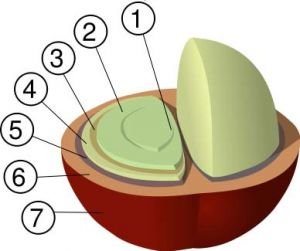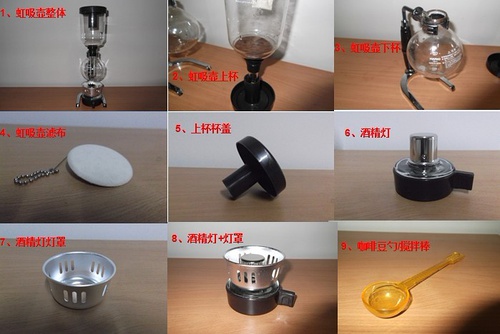From the composition and composition of coffee beans to talk about the acidity of coffee to understand the structural growth substances of coffee beans

Caffeic acid
Caffeic acid [English name] Caffeic acid
Organic acids and phenols
Coffee acidity is perhaps the most incorrect and misunderstood term used to evaluate the taste of coffee is "acidity". This is a quantitative term that refers to the relative strength of the acidic components in the liquid being evaluated. Although the coffee term "sour" is related to the term "acidic" that describes taste, the two terms are not interchangeable. In fact, coffee, described as "very sour", is not very acidic.
In chemistry, "acid" is defined as a compound containing hydrogen atoms. This hydrogen atom can release protons (hydrogen ions). This compound can be measured in quantity. For food technicians, almost all drinks are sour. Their relative strength is expressed by PH. The PH value is used to express the amount of free hydrogen ions in the liquid. Coffee contains all kinds of acids, most of which can be found in other agricultural products. These acids include amino acids, such as asparagic acid, glutamic acid and leucine; carbonic acid, such as caffeic acid, chlorogenic acid and quinic acid; and fatty acids, such as acetic acid, lactic acid, citric acid, fumaric acid, oxalic acid, phosphoric acid and tartaric acid. From the taste point of view, when the concentration of amino acids exceeds the normal value, it will produce sweetness; when the concentration of carbolic acid exceeds the normal value, it will produce bitter taste; and high concentrations of fatty acids will produce sour taste.
1. From the point of view of the concentration of chlorogenic acid, the volume proportion of stone carbonic acid in coffee water is the largest. The most ingredient in this series is chlorogenic acid. There are three main groups of chlorogenic acid in coffee: coffee tannic acid, fermented quinic acid and double coffee tannic acid. Although few people have studied the sensory properties of chlorogenic acid, studies have shown that the number of acids (robusta beans are more than Arabica beans) and different proportions (some acids are more concentrated in immature and overripe beans than in normally ripe beans) play a major role in people's identification with a certain type of coffee. The chlorogenic acid series also determines the taste of freshly brewed coffee. Chlorogenic acid is very unstable. The chlorogenic acid of coffee in the coffee pot breaks down into caffeic acid and quinic acid, especially when the temperature is below 80 ℃ or above 85 ℃. After decomposition, quinic acid will immediately show obvious bitter taste, caffeic acid will show sour taste. Sour and bitter are mixed to form a sour and bitter taste. Remember that 35 uses a thermometer when making coffee by hand? That's why)
Fatty acids another very important acid is fatty acids. Although it is not the largest, it tends to produce the largest amount of hydrogen ions. The hydrogen ion measured by pH value is related to the sour taste of coffee. From a taste point of view, fatty acids give coffee a sense of brightness and aroma. This is why coffee with high acidity (with a low pH of 4.8 to 5.1) usually sells for a high price. The order of the strength of acids in coffee is generally in this order: tartaric acid, citric acid, malic acid, lactic acid and acetic acid. In addition, acid concentration also affects other major flavors of coffee water, especially sweetness. Each acid has its own flavor, such as lemon of citric acid, butter of lactic acid, apple of malic acid and so on. But they are more likely to be sensed by smell than by taste. Acetic acid in coffee is a special case. Its appearance is generally the result of the fermentation of washed coffee. The control of fermentation is the key to the quality control of this processing method. If too much acetic acid is produced, raw beans will produce a fruity flavor. The appearance of fruity flavor means that brewed coffee has an extremely disgusting fermented taste. (this is why leisurely coffee chooses high quality raw beans.)
3. Compared with wine, the acids that affect the taste of coffee are limited. This is why the aroma of coffee is locked in the aroma of coffee. Because of the complex and changeable taste of the acidity in the wine, the process of wine tasting is an interesting taste movement process, while the cup review of coffee poses a challenge to the sense of smell because there are a variety of complex and volatile components in coffee.
Source: Sina Weibo leisurely Pavilion
Important Notice :
前街咖啡 FrontStreet Coffee has moved to new addredd:
FrontStreet Coffee Address: 315,Donghua East Road,GuangZhou
Tel:020 38364473
- Prev

How to judge whether a latte is good or bad? How to make a cup of Italian fancy coffee?
The beauty of vision pays attention to the golden section, while the beauty of taste pays attention to balance. Looking at Hell's Kitchen, you will find that the word Balance appears frequently. This is the intention of leisurely coffee. After milk is heated, it will produce vanilla, almonds, cream and other aroma and sweetness. Fancy coffee can drink not only the aroma of coffee, but also the sweetness of milk. They blend with each other and do not rob each other. Latte (caffe la)
- Next

Knowledge of siphon pot brewing coffee: detailed explanation of the principle and operation process of siphon pot brewing coffee
Siphon pot, also known as plug-wind pot, is a common tool for individuals and characteristic cafes to make coffee. It has a history of more than 200 years. It needs to master the thickness of coffee powder, heat and the time of coffee extraction, so it belongs to a professional coffee vessel. Because of its special shape and working principle, this instrument is jokingly called a chemical instrument by many people.
Related
- What is the meaning of lactic acid fermentation with coffee bean treatment?
- How to judge the state of foam by sound?
- How does the latte pull out the unicorn pattern? Come to get for a little trick to improve the flower pull!
- Will flower pulling affect the taste of the latte?
- Do you know the history of coffee?
- The difference between honey treatment and sun washing what is raisin honey treatment?
- What kind of milk can a novice use to make coffee foam to keep the foam longer? The correct method and skills of milking tutorial sharing
- Why do washed coffee beans taste sour? Flavor characteristics of washed Coffee
- Introduction to the skill of how to practice the size and height of water injection around the circle of hand-brewed coffee
- How do beginners practice coffee flower drawing from scratch?

